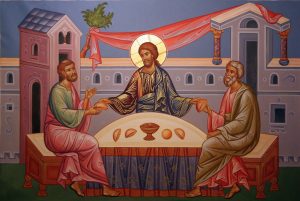
One of the images for the Great Fast is that of a journey. Since the Fast lasts 40 days, the 40 year journey of the Israelites through the desert to the Promised Land is a particularly powerful image. The Israelites were fed on manna in the desert, but in our journey we are fed by the Body of Christ in the Presanctified Liturgy. Jesus said: “I am the bread of life. Your ancestors ate the manna in the desert, but they died. This is the bread that comes down from heaven so that one may eat it and not die. I am the living bread that came down from heaven; whoever eats this bread will live forever; and the bread that I will give is my flesh for the life of the world” (John 6:48-51).
The readings from Zechariah tell us of another journey: “Thus says the Lord of hosts: I am going to rescue my people from the land of the rising sun, and from the land of the setting sun. I will bring them back to dwell within Jerusalem … Many peoples and strong nations will come to seek the Lord of hosts in Jerusalem and to implore the favor of the Lord” (Zechariah 8:7-8.22). Jerusalem is our goal. There our Lord died and there he gave us life. Our Lord said, “Yet I must continue on my way today, tomorrow, and the following day, for it is impossible that a prophet should die outside of Jerusalem” (Luke 13:33).
We are invited to follow him in our hearts to the heavenly Jerusalem where all glory will be fulfilled.
Meditation by Archpriest David Petras
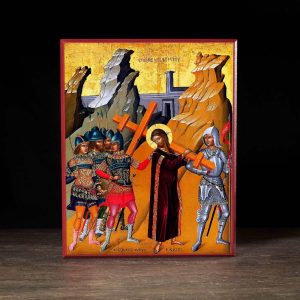 In Cheesefare Week, we read the passion of our Lord according to St. Luke. What strikes me today is how the passion affects the people around Jesus. The women of Jerusalem receive a warning. The corrupt rulers Pilate and Herod make up and become friends. The venerable Joseph of Arimathea, member of the council, who “had not consented to their decision and deed,” courageously asks for the body of Jesus and gives it burial.
In Cheesefare Week, we read the passion of our Lord according to St. Luke. What strikes me today is how the passion affects the people around Jesus. The women of Jerusalem receive a warning. The corrupt rulers Pilate and Herod make up and become friends. The venerable Joseph of Arimathea, member of the council, who “had not consented to their decision and deed,” courageously asks for the body of Jesus and gives it burial.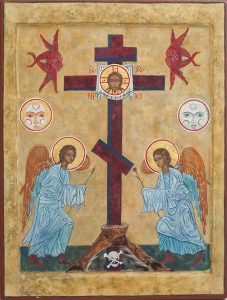 The first half of the Great Fast tells us the stories of Adam and Eve and their children, and the flood of Noah. It is a story of the creation of a perfect world and how that has been marred by human sin. It tells of the end of paradise, “The Lord God therefore banished him from the garden of Eden, to till the ground from which he had been taken. He expelled the man, stationing the cherubim and the fiery revolving sword east of the garden of E
The first half of the Great Fast tells us the stories of Adam and Eve and their children, and the flood of Noah. It is a story of the creation of a perfect world and how that has been marred by human sin. It tells of the end of paradise, “The Lord God therefore banished him from the garden of Eden, to till the ground from which he had been taken. He expelled the man, stationing the cherubim and the fiery revolving sword east of the garden of E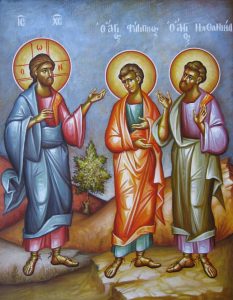 This Sunday is called the “Sunday of Orthodoxy” because it commemorates the restoration of the Church’s teaching on making images (icons) of our Lord and the saints in the year 843. Before that, it was the Sunday of the Commemoration of the Holy Prophets. This explains the Gospel, Phillip witnesses to Nathanael: “We have found him of whom Moses in the law and also the prophets, wrote – Jesus of Nazareth, the son of Joseph.” This is our goal in the Great Fast – to find our faith in Jesus. The Great Fast was the training period for those about to be baptized, and it was a time for the whole community to rediscover its faith. Along the journey to Holy Week, we read especially from the book of Genesis and from Isaiah to guide us to Christ, who will perfect his covenant with us by his death and resurrection. This is why, in the Apostolic reading, we remember Moses, Gideon, Barak, Samson, Jephthah, David and Samuel and all the prophets. It was all for Jesus, “Yet all these, though approved because of their faith, did not receive what had been promised. God had foreseen something better for us, so that without us they should not be made perfect. (Hebrews 11:39)”
This Sunday is called the “Sunday of Orthodoxy” because it commemorates the restoration of the Church’s teaching on making images (icons) of our Lord and the saints in the year 843. Before that, it was the Sunday of the Commemoration of the Holy Prophets. This explains the Gospel, Phillip witnesses to Nathanael: “We have found him of whom Moses in the law and also the prophets, wrote – Jesus of Nazareth, the son of Joseph.” This is our goal in the Great Fast – to find our faith in Jesus. The Great Fast was the training period for those about to be baptized, and it was a time for the whole community to rediscover its faith. Along the journey to Holy Week, we read especially from the book of Genesis and from Isaiah to guide us to Christ, who will perfect his covenant with us by his death and resurrection. This is why, in the Apostolic reading, we remember Moses, Gideon, Barak, Samson, Jephthah, David and Samuel and all the prophets. It was all for Jesus, “Yet all these, though approved because of their faith, did not receive what had been promised. God had foreseen something better for us, so that without us they should not be made perfect. (Hebrews 11:39)”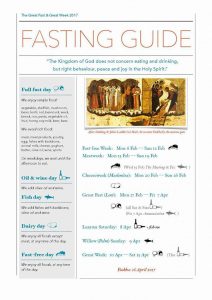

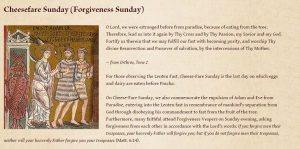
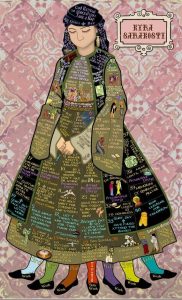 Today, the Church calls this Sunday “Forgiveness Sunday” and you may also know it as Cheesefare Sunday. The Byzantine Church uses the image of Lady Lent to illustrate (especially to children) the meaning of Lent in an accessible way.
Today, the Church calls this Sunday “Forgiveness Sunday” and you may also know it as Cheesefare Sunday. The Byzantine Church uses the image of Lady Lent to illustrate (especially to children) the meaning of Lent in an accessible way.